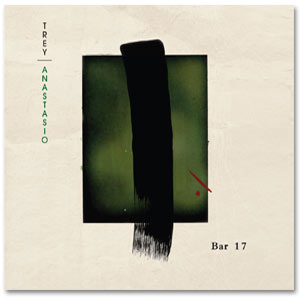Shadow
| Originally Performed By | Trey Anastasio |
| Original Album | Bar 17 (2006) |
| Appears On |

|
| Music/Lyrics | Anastasio |
| Historian | Tim Wade (TheEmu) |
| Last Update | 2015-07-03 |
History
Bar 17 and 18 Steps provide a fascinating snapshot of Trey’s development as a solo artist. Begun before 2005’s Shine, but completed afterwards, these albums have one foot in TAB’s early swing period and one on the other side of Shine’s poppier sound. The music on Trey Anastasio was heavily influenced by King Sunny Adé, Trey told High Times in a 2002 interview. “Sophisticated, elegant, harmonic language that comes from swing-band concepts, and then I keep hearing King Sunny Adé as a reference point on the other end. . . . The idea I wanted to take from King Sunny Adé was the concept of having a lot of people playing small parts that are intertwined together.”
King Sunny Adé, “Mo Ti Mo” - 1983Often this involved “horn parts bouncing off the guitar solos,” Trey said, an appropriate term considering his longtime use of the concept. "The style of my writing seems to vary from album to album, a little more pop, a little more orchestral, a little jazzier,” Trey told GuitarWorld in 2007 following the release of The Horseshoe Curve. “But if you listen closely to the vocal layers in [Phish songs] 'Twist' or 'Bouncing Around the Room' you'll hear that they're not very far removed from the horn lines in 'Sidewalks of San Francisco' or 'Burlap Sack and Pumps.'”
TAB, “Burlap Sack and Pumps” - 2/22/11, New York, NYWeaving small parts into a full sound is the principle that runs through “Shadow,” one of many impressive compositions on Bar 17 and 18 Steps. The song starts by using three backing vocal lines to support the lead, but all four parts support each other musically while undercutting each other lyrically. “A place to find,” but “she gone good.” “It’s all very good,” but “that will never be.” The shadow isn’t a place to hide, it’s “a place to find,” and a great deal of exploration evolves from there. Strings take the place of the vocals, and the guitar solo becomes wrapped in them, attentively pulling at different threads. “Shadow” shines a light on Trey’s skill arranging voice and other instruments, and the song is another reason not to overlook Bar 17/18 Steps.
The studio version of “Shadow” may be the definitive take on the song, but it was played live a handful of times. Without the strings to accompany Trey, though, the song loses much of its compelling dynamic. Three of the four performances feature only the standard TAB lineup, but on 10/8/06, Trey was joined by a Don Hart-conducted string quartet for a much stronger rendition of the tune. If the song was retired following the New Year’s Eve 2006 show because it doesn’t work as well without the strings, then perhaps there is hope that at some future orchestral gig, “Shadow” will be found again.

 The Mockingbird Foundation
The Mockingbird Foundation